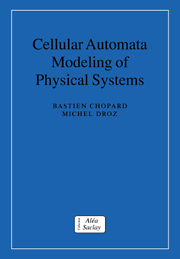3 - Statistical mechanics of lattice gas
Published online by Cambridge University Press: 26 October 2009
Summary
The one-dimensional diffusion automaton
In the previous chapter, we discussed several cellular automata rules which definitely had something to do with the description of physical processes. The question is of course how close these models are to the reality they are supposed to simulate?
In the real world, space and time are not discrete and, in classical physics, the state variables are continuous. Thus, it is crucial to show how a cellular automaton rule is connected to the laws of physics or to the usual quantities describing the phenomena which is modeled. This is particularly important if the cellular automaton is intended to be used as a numerical scheme to solve practical problems.
Lattice gas automata have a large number of potential applications in hydrodynamics and reaction-diffusion processes. The purpose of this chapter is to present the techniques that are used to establish the connection between the macroscopic physics and the microscopic discrete dynamics of lattice gas automata. The problem one has to address is the statistical description of a system of many interacting particles. The methods we shall discuss here are very close, in spirit, to those applied in kinetic theory: the N-body dynamics is described in terms of macroscopic quantities such as the particle density or the velocity field. The derivation of a Boltzmann equation is a main step in this process.
In order to illustrate and understand the main steps leading to a macroscopic description of a cellular automaton model, we first consider a linear rule for which a simple and rigorous calculation can be carried out.
- Type
- Chapter
- Information
- Cellular Automata Modeling of Physical Systems , pp. 66 - 137Publisher: Cambridge University PressPrint publication year: 1998



